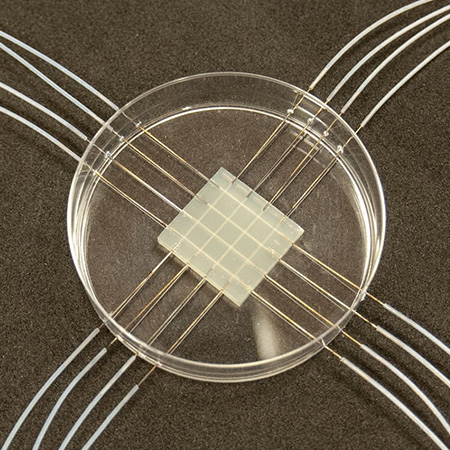Development of the World's First Multidimensional Antimicrobial Susceptibility Testing (AST) System
Overview
This is the world-first rapid 2D antimicrobial susceptibility testing (AST) system that can practically assist routine prescription. While ASTs in clinical practice are too slow (>10h) to be adopted as a default procedure before prescription, rapid ASTs reported till now are still impractical for reliably guiding treatment due to the possible deviation from treatment outcomes, which could be attributed to not only the none-physiological testing condition but also the incapability in testing drug combinations and polymicrobial behaviours (samples have to be isolated into single species).
This rapid 2D AST utilizes the molecular diffusion of drugs from perpendicularly laid microchannels inside a hydrogel membrane and cultures specimen on its top surface. This design allows formation of steady orthogonal gradient of drug (or assisting agent) combinations on which cells at different position on the membrane experience different testing conditions. Combined with single-cell imaging analysis, the test could be completed within 3 hours and yet able to test polymicrobial specimen directly. The testing is affordable and generally close to physiological conditions, yet it is further extendable to provide molecular information of the specimen. The invention will aid diagnosis by reliably selecting the right type and dosage of antibiotics in treatment.
Project-in-charge
Dr Kangning Ren
Associate Professor and Programme Director, Department of Chemistry
Key Features
- Precision medicine ─ with the use of artificial intelligence (AI), aid diagnosis by providing doctors with a precise prescription which will significantly reduce the chance of antibiotic abuse or misuse
- Rapid turnaround time – 10-20 times faster than conventional phenotypic ASTs, only takes around four hours to indicate the effectiveness of the antibiotic treatment and whether it’s needed
- Low sample pretreatment requirements ─ only requires a small amount of patient sample and free of bacteria isolation step
- Low operation cost – ~2 USD per chip [1/30 price of a VITEK® card]
- Multi-information – available to test drug combinations and polymicrobial specimens which are unavailable in existing technologies




Technology Readiness Level


Potential Applications
- Frequent safety screenings of water, food, and public facilities
- Urgent surveys of massive samples during pandemics or infectious disease outbreaks
- AMR tests in low-income countries or resource-limited settings
- Screening for drug-resistant bacteria in various environments
Market Outlook & Unique Value Proposition
According to the marketing report from Allied Market Research, the global antimicrobial susceptibility testing market was valued at $3,040.00 million in 2020 and is projected to reach $4,736.03 million by 2030, registering a CAGR of 5.8% from 2021 to 2030.
The United States has been building a solid foundation for public health preparedness to address antimicrobial resistance. Since 2016, CDC has funded more than $160 million in 300 projects and collaborated with more than 100 public and private institutions to address knowledge gaps with scalable, innovative solutions.
The "barcode" AST system represents a breakthrough in the field of AST, enabling rapid and cost-efficient screening of drug-resistant bacteria. By employing a microscope-free analysis, it eliminates the need for expensive equipment while providing reliable results consistent with conventional AST techniques. The system's short turnaround time, affordability, portability, high throughput, and user-friendliness make it an invaluable asset in addressing the demands of AST in resource-limited conditions.
Representative Publications
Chan, C-W., Sun, H., Wang, Y., Zhao, Z., O'Neill, R., Siu, S-Y., Chu, X., Banaei, N., & Ren, K. (2021). “Barcode” cell sensor microfluidic system: Rapid and sample-to-answer antimicrobial susceptibility testing applicable in resource-limited conditions. Biosensors and Bioelectronics, 192, [113516]. https://doi.org/10.1016/j.bios.2021.113516
Patents
- PCT application no. PCT/CN2022/094665